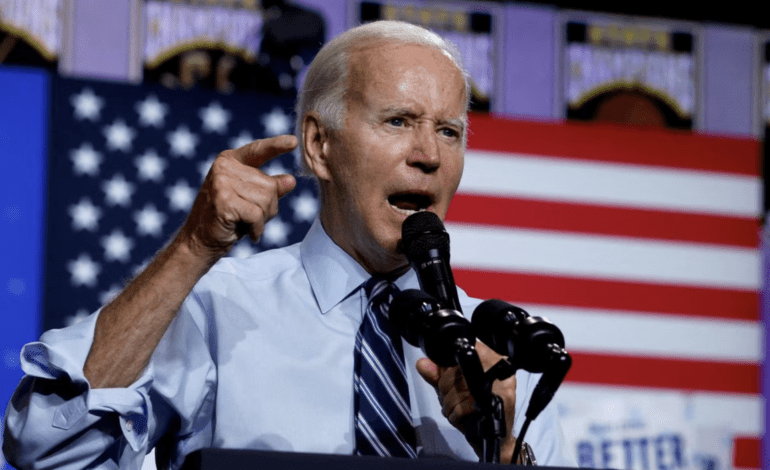PHILADELPHIA – On Thursday, President Biden unveiled plans for government spending and higher taxes on the wealthy, choosing the swing state of Pennsylvania to reveal his playbook for an expected 2024 re-election bid.
Speaking at a Philadelphia union hall, the Democratic president challenged his Republican opposition on fiscal responsibility, highlighting plans to cut the nation’s deficit by nearly $3 trillion over 10 years by raising taxes on those earning more than $400,000 a year.
Overall, the budget would increase federal spending in the 12 months starting in October to $6.8 trillion from the $6.2 trillion spent in the 2022 fiscal year.
“For too long, working people been breaking their necks, the economy’s left them behind — working people like you — while those at the top get away with everything,” Biden told the Pennsylvania blue-collar workers, a group he targeted in his 2020 presidential campaign.
Biden’s budget proposal already faces stiff opposition from Republican lawmakers emboldened by winning control of the House of Representatives in November’s midterm elections. Large parts of his agenda are unlikely ever to be enacted by this Congress.
The plan, however, is a political statement that directly challenges Republican House Speaker Kevin McCarthy’s threats to block an increase in the $31.4 trillion limit on federal borrowing unless Biden agrees to rein in federal spending.
“I want to make it clear I’m ready to meet with the speaker anytime, tomorrow if he has his budget,” Biden said. “Lay it down, tell me what you want to do. I’ll show you what I want to do, see what we can agree on.”
On Thursday, McCarthy and other Republicans described Biden’s budget plan as “a reckless proposal.”
The president seeks to fund higher spending and narrowing the deficit by imposing a 25 percent minimum tax on billionaires and doubling the capital gains tax from 20 percent, the White House said.
He also wants to quadruple a 1 percent stock buyback tax, potentially picking a fight with many of the investors he would need to call on to finance any re-election campaign. The measures would roll back some corporate tax breaks enacted in 2017 under Republican former President Trump, a key promise from the 2020 Democratic campaign.
Political messaging aside, the Biden budget makes clear one thing — the aging U.S. population means that legally mandated spending on social programs will continue to be a long-term drag. One in five Americans will be retirement age or older by 2030, the U.S. Census predicts.
The budget projects more than $1 trillion deficits every year over the next 10 years, even if Biden gets his requests for higher taxes and cost-cutting measures.
Total U.S. debt would rise to nearly 110 percent of annual gross domestic product in 2033, a figure that rivals the peaks during the country’s mobilization for World War II.
For the upcoming fiscal year, the administration projected 1.5 percent economic growth, unemployment at 4.6 percent and 2.4 percent consumer price increases, an optimistic scenario where inflation falls by nearly two-thirds from current levels and the country dodges the risks from higher interest rates and a debt limit crisis.
Republican pushback
“President Joe Biden’s budget is a reckless proposal doubling down on the same Far Left spending policies that have led to record inflation and our current debt crisis,” McCarthy and other Republicans said in a statement.
The budget contains “trillions in new taxes that families will pay directly or through higher costs,” they said.
Maya MacGuineas, president of the Committee for a Responsible Federal Budget advocacy group, said the budget did not go nearly far enough to rein in dangerous debt levels or the long-term funding challenges associated with the Social Security old-age program.
“When it comes to fixing the debt, this is by no means an award-winning budget, but the president deserves at least a participation trophy,” she said.
Republicans are already preparing $150 billion in cuts to non-defense discretionary programs, including about $25 billion from the Department Education and cuts in foreign aid and programs aimed at preventing sexually transmitted diseases. They say that would save $1.5 trillion over a decade.
Biden’s proposals, meanwhile, are a sweeping endorsement of the power of the federal government to solve big problems.
He would boost military spending to stop China and Russia pushing beyond their borders, extend healthcare subsidies for the country’s aging population while funding cancer research to cut the death rate from that disease in half, support down payments for first-time homebuyers, improve rail safety after recent accidents and guarantee preschool for all the country’s four million 4-year-olds.
Aides see those proposals as enjoying strong bipartisan support in the country, hoping they could lift the president’s low approval ratings as he gears up announce his reelection bid as soon as next month.
It also includes an additional $800 million over 2022’s enacted budget for border and immigration services, a nod to Republicans’ call for more enforcement on the country’s southern border.
– Reuters. Edited for style.






Leave a Reply